2013 VOLKSWAGEN GOLF GTI brake
[x] Cancel search: brakePage 123 of 319
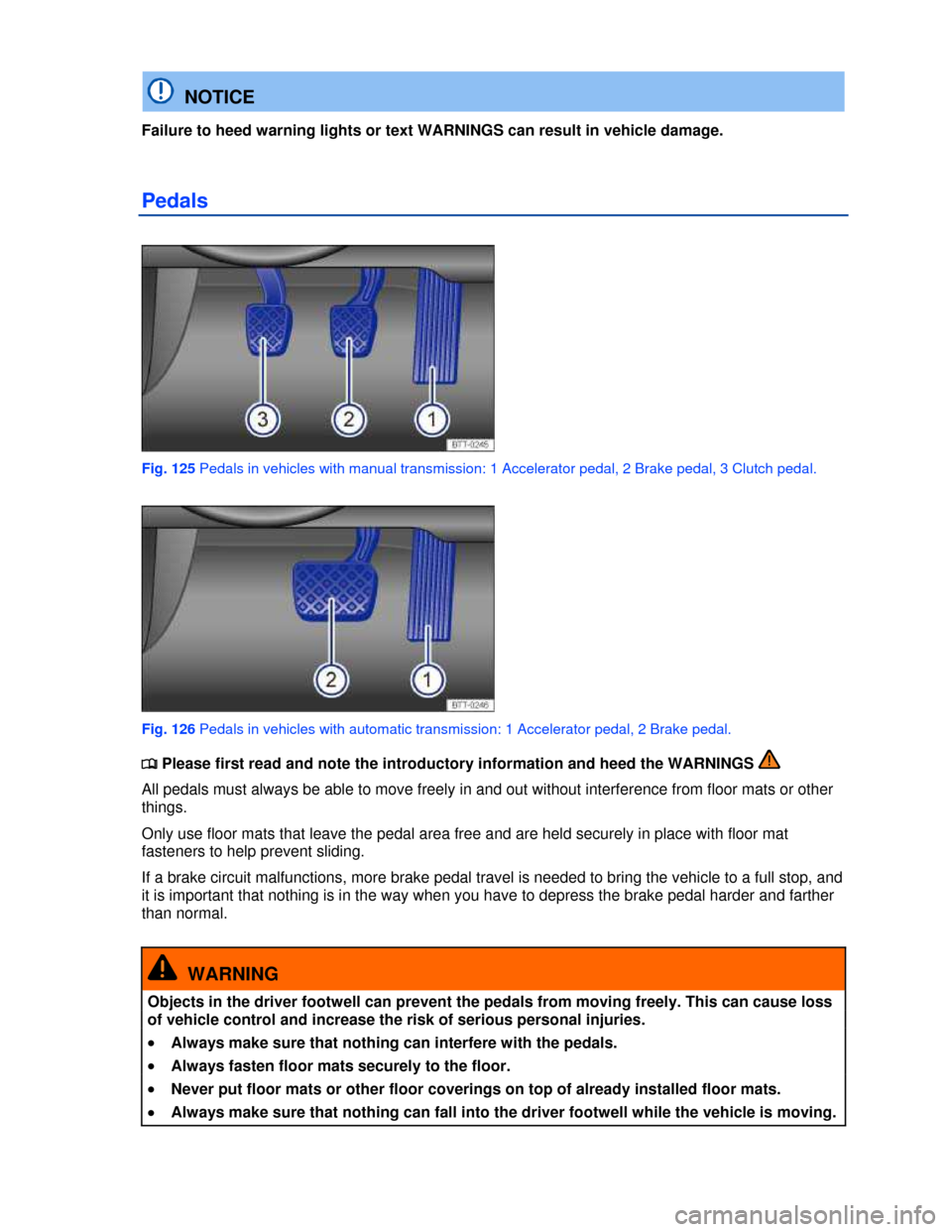
NOTICE
Failure to heed warning lights or text WARNINGS can result in vehicle damage.
Pedals
Fig. 125 Pedals in vehicles with manual transmission: 1 Accelerator pedal, 2 Brake pedal, 3 Clutch pedal.
Fig. 126 Pedals in vehicles with automatic transmission: 1 Accelerator pedal, 2 Brake pedal.
�
Page 124 of 319
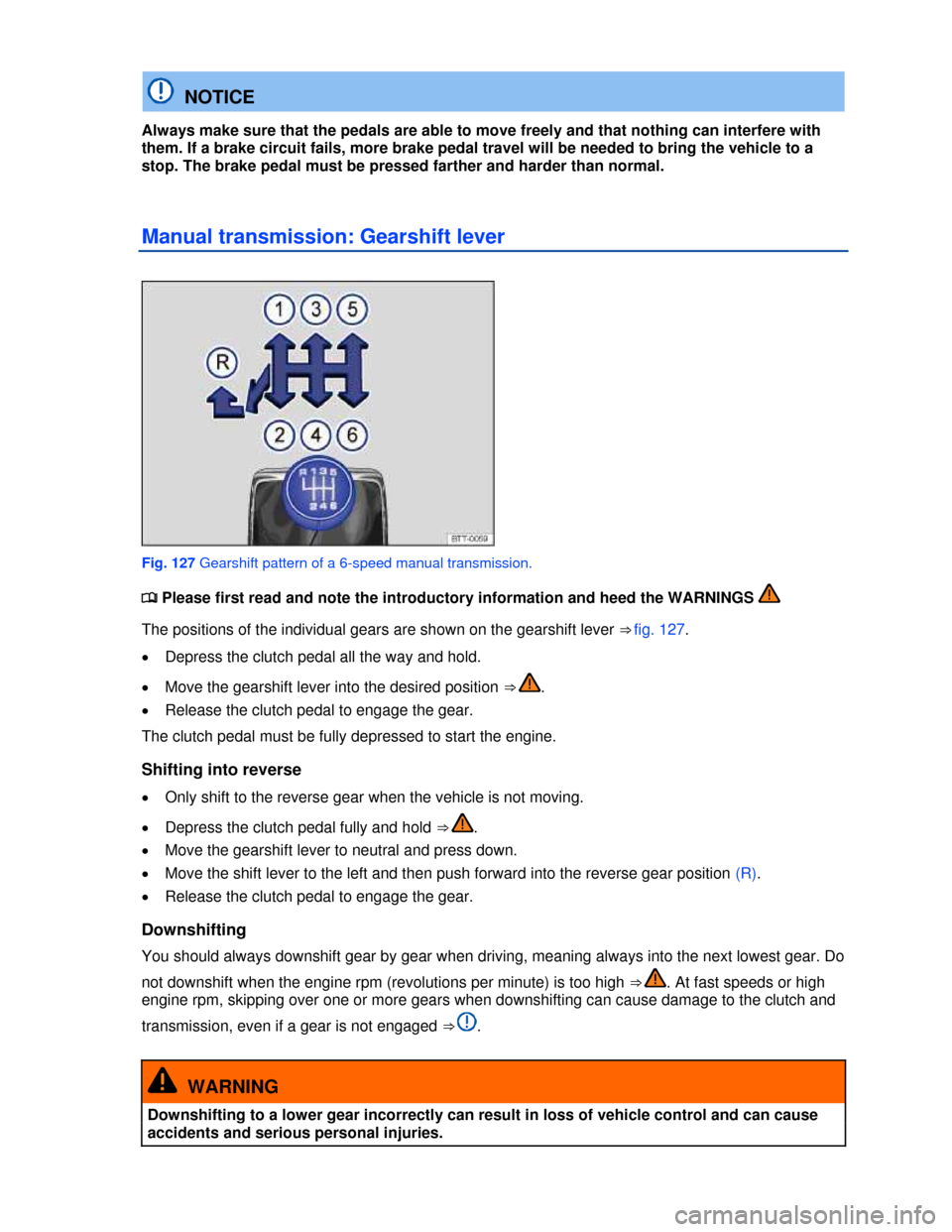
NOTICE
Always make sure that the pedals are able to move freely and that nothing can interfere with
them. If a brake circuit fails, more brake pedal travel will be needed to bring the vehicle to a
stop. The brake pedal must be pressed farther and harder than normal.
Manual transmission: Gearshift lever
Fig. 127 Gearshift pattern of a 6-speed manual transmission.
�
Page 125 of 319
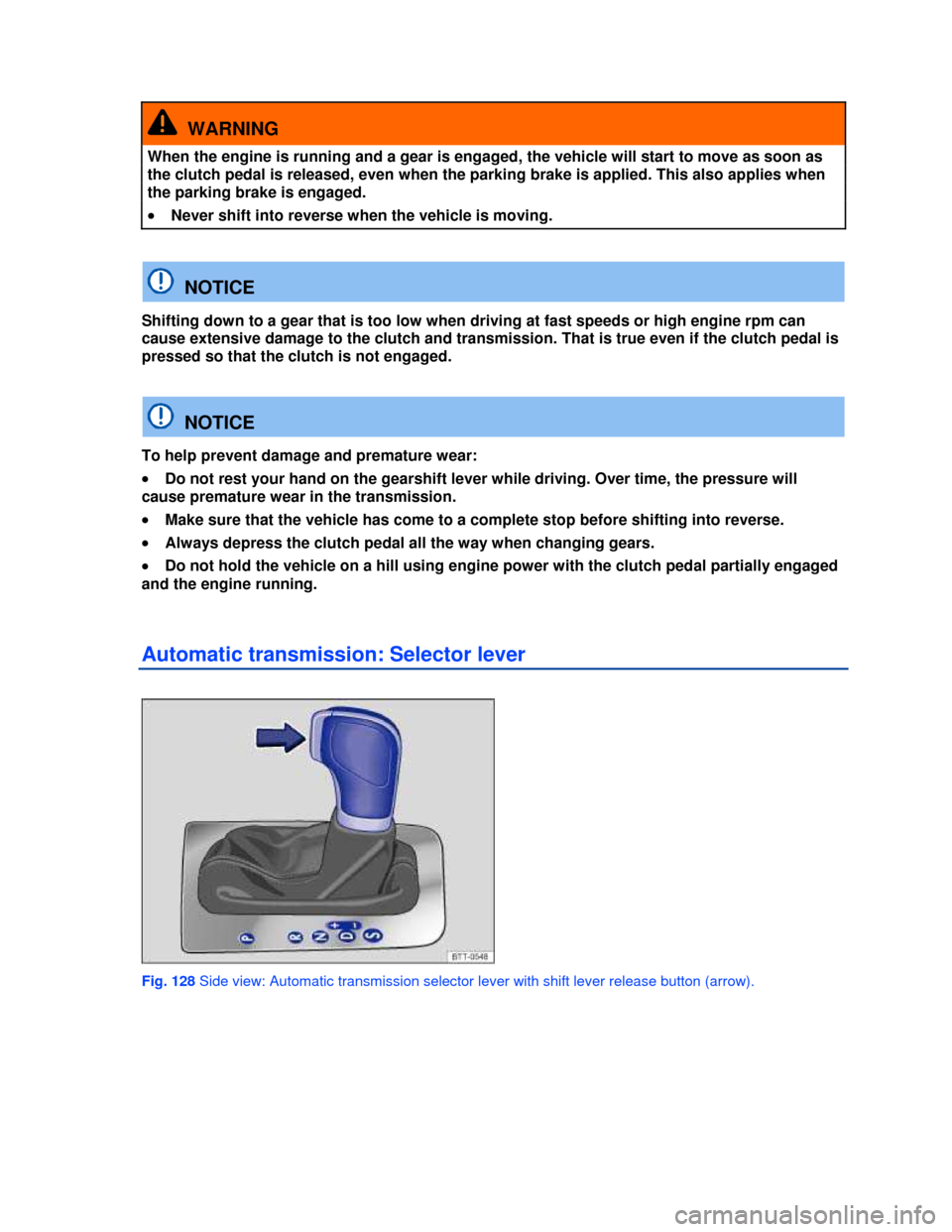
WARNING
When the engine is running and a gear is engaged, the vehicle will start to move as soon as
the clutch pedal is released, even when the parking brake is applied. This also applies when
the parking brake is engaged.
�x Never shift into reverse when the vehicle is moving.
NOTICE
Shifting down to a gear that is too low when driving at fast speeds or high engine rpm can
cause extensive damage to the clutch and transmission. That is true even if the clutch pedal is
pressed so that the clutch is not engaged.
NOTICE
To help prevent damage and premature wear:
�x Do not rest your hand on the gearshift lever while driving. Over time, the pressure will
cause premature wear in the transmission.
�x Make sure that the vehicle has come to a complete stop before shifting into reverse.
�x Always depress the clutch pedal all the way when changing gears.
�x Do not hold the vehicle on a hill using engine power with the clutch pedal partially engaged
and the engine running.
Automatic transmission: Selector lever
Fig. 128 Side view: Automatic transmission selector lever with shift lever release button (arrow).
Page 127 of 319

The ASL is not engaged if the selector lever is moved quickly through Neutral (N) (e.g., when shifting
from Reverse (R) to Drive (D)). This makes it possible to “rock” the vehicle backwards and forwards if
it is stuck in snow or mud. The ASL engages automatically if the brake pedal is not depressed and the
lever is in Neutral (N) for more than about 1 second and the vehicle is traveling no faster than about
3 mph (5 km/h).
In rare cases, the ASL may not engage on vehicles with DSG® Direct Shift Gearbox. If this happens,
power to the drive wheels will be interrupted to prevent the vehicle from moving unexpectedly. The
green indicator light k will blink and a text message will be displayed. To engage the Automatic Shift
Lock (ASL):
�x On 6-speed transmissions: Depress and then release the brake pedal. Try to engage the ASL
again.
�x On 7-speed transmissions: First shift into Park (P) or Neutral (N), and then shift to a drive position.
WARNING
Moving the selector lever to the wrong position can cause loss of vehicle control, a collision,
and serious personal injury.
�x Never accelerate when moving the selector lever.
�x When the engine is running and a drive position is engaged, the vehicle will start to move
as soon as the brake pedal is released.
�x Never shift into Reverse or Park when the vehicle is moving.
WARNING
Unintended vehicle movement can cause serious personal injury.
�x Never get out of the driver's seat while the engine is running, especially when the
transmission is in a drive gear. If you must leave your vehicle while the engine is running,
always set the parking brake and shift the transmission into Park (P).
�x Never leave the vehicle in Neutral (N). It will roll down hills, whether the engine is running
or not.
�x When the engine is running and a drive gear - Drive (D), Sport Drive (S), or Reverse (R) -
has been selected, press and hold the brake pedal to keep the vehicle from moving. The
vehicle may “creep” and move forward or backward even if the engine is idling slowly.
�x Never shift into Reverse (R) or Park (P) when the vehicle is moving.
NOTICE
Even though the transmission is in Park (P), the vehicle may move a couple of inches (a few
centimeters) forwards or backwards if you take your foot off the brake pedal after stopping the
vehicle without first setting the parking brake.
If the selector lever is moved into Neutral (N) by mistake when the vehicle is moving, take your
foot off the accelerator pedal. Wait until the engine speed has dropped to idle speed before moving
the selector lever into a drive gear.
Leaving the selector lever for a long period of time in any position other than Park (P) when the
ignition is switched off can drain the vehicle battery.
Page 137 of 319
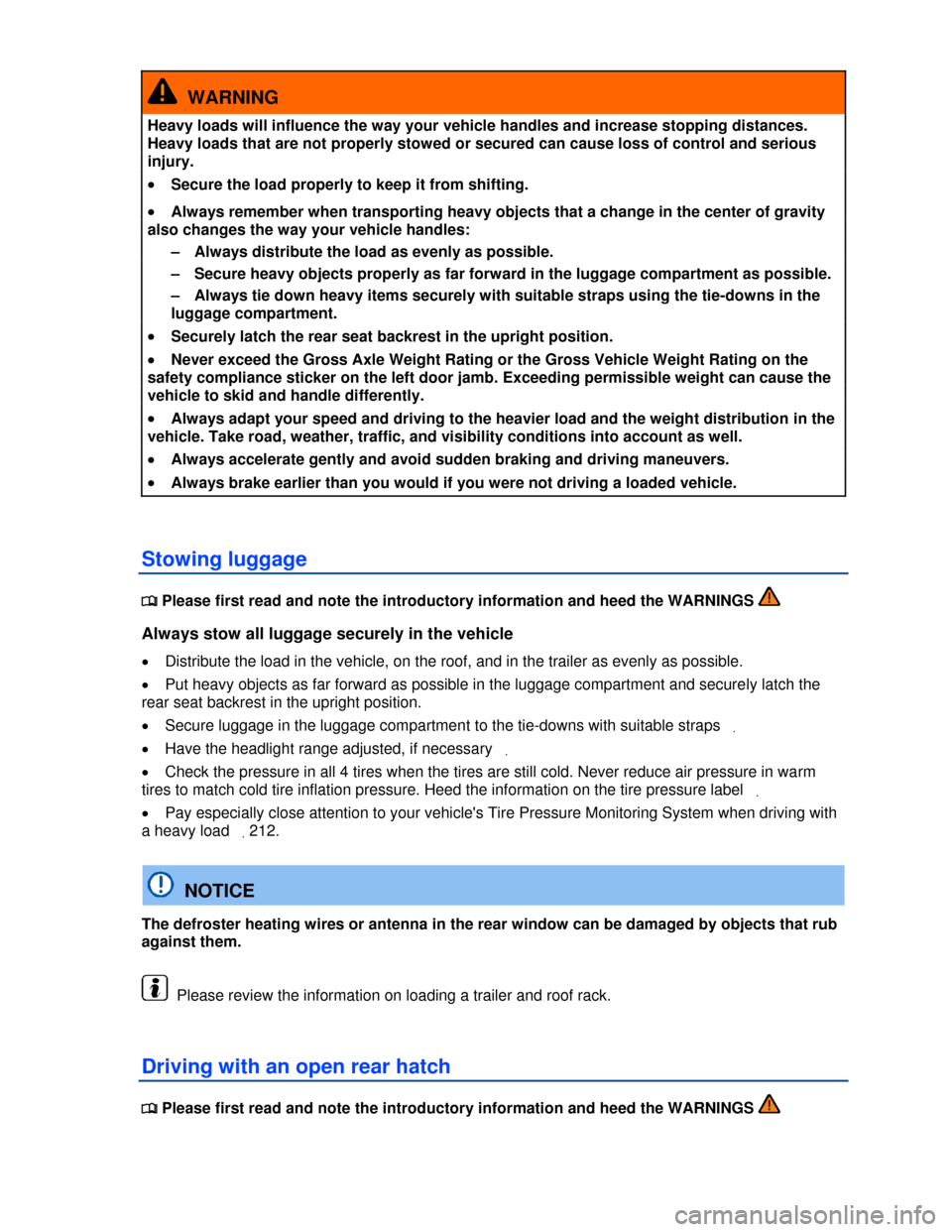
WARNING
Heavy loads will influence the way your vehicle handles and increase stopping distances.
Heavy loads that are not properly stowed or secured can cause loss of control and serious
injury.
�x Secure the load properly to keep it from shifting.
�x Always remember when transporting heavy objects that a change in the center of gravity
also changes the way your vehicle handles:
– Always distribute the load as evenly as possible.
– Secure heavy objects properly as far forward in the luggage compartment as possible.
– Always tie down heavy items securely with suitable straps using the tie-downs in the
luggage compartment.
�x Securely latch the rear seat backrest in the upright position.
�x Never exceed the Gross Axle Weight Rating or the Gross Vehicle Weight Rating on the
safety compliance sticker on the left door jamb. Exceeding permissible weight can cause the
vehicle to skid and handle differently.
�x Always adapt your speed and driving to the heavier load and the weight distribution in the
vehicle. Take road, weather, traffic, and visibility conditions into account as well.
�x Always accelerate gently and avoid sudden braking and driving maneuvers.
�x Always brake earlier than you would if you were not driving a loaded vehicle.
Stowing luggage
�
Page 139 of 319

�x Securely stow all luggage
�x Drive especially carefully and accelerate gently.
�x Avoid sudden braking and driving maneuvers.
�x Brake earlier than you would if you were not driving a loaded vehicle.
�x If applicable, observe information about driving with a trailer
�x If applicable, observe information about driving with a roof rack
WARNING
Heavy loads can change the way your vehicle handles and increase stopping distances.
Heavy loads that are not properly stowed or secured can shift suddenly, causing loss of
control and serious injury.
�x Secure the load properly to keep it from shifting.
�x Always remember when transporting heavy objects that they change the vehicle's center
of gravity and also the way it handles.
– Always distribute the load as evenly as possible.
– Secure heavy objects as far forward in the luggage compartment as possible.
– Use your vehicle's luggage compartment tie-downs with suitable straps.
�x Always tie down heavy items securely with suitable straps.
�x Securely latch the rear seat backrest in the upright position.
�x Never exceed the Gross Axle Weight Rating or the Gross Vehicle Weight Rating on the
safety compliance sticker on the left door jamb. Exceeding permissible weight can cause the
vehicle to skid and handle differently.
�x Always adapt speed and driving to the heavier load and the weight distribution in the
vehicle. Take road, weather, traffic, and visibility conditions into account as well.
�x Always accelerate gently and avoid sudden braking and driving maneuvers.
�x Always brake earlier than you would if you were not driving a loaded vehicle.
Weights and axle weights
�
Page 142 of 319
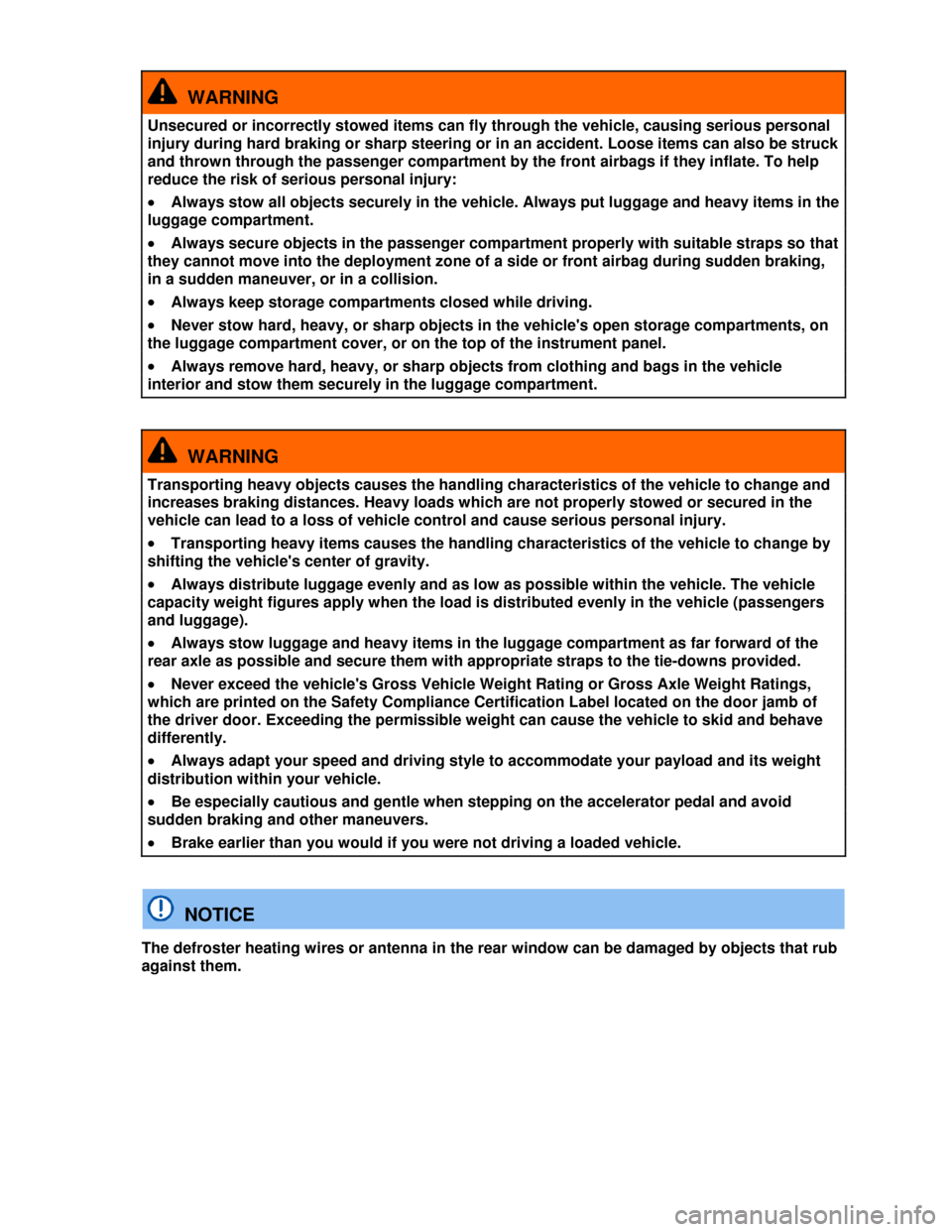
WARNING
Unsecured or incorrectly stowed items can fly through the vehicle, causing serious personal
injury during hard braking or sharp steering or in an accident. Loose items can also be struck
and thrown through the passenger compartment by the front airbags if they inflate. To help
reduce the risk of serious personal injury:
�x Always stow all objects securely in the vehicle. Always put luggage and heavy items in the
luggage compartment.
�x Always secure objects in the passenger compartment properly with suitable straps so that
they cannot move into the deployment zone of a side or front airbag during sudden braking,
in a sudden maneuver, or in a collision.
�x Always keep storage compartments closed while driving.
�x Never stow hard, heavy, or sharp objects in the vehicle's open storage compartments, on
the luggage compartment cover, or on the top of the instrument panel.
�x Always remove hard, heavy, or sharp objects from clothing and bags in the vehicle
interior and stow them securely in the luggage compartment.
WARNING
Transporting heavy objects causes the handling characteristics of the vehicle to change and
increases braking distances. Heavy loads which are not properly stowed or secured in the
vehicle can lead to a loss of vehicle control and cause serious personal injury.
�x Transporting heavy items causes the handling characteristics of the vehicle to change by
shifting the vehicle's center of gravity.
�x Always distribute luggage evenly and as low as possible within the vehicle. The vehicle
capacity weight figures apply when the load is distributed evenly in the vehicle (passengers
and luggage).
�x Always stow luggage and heavy items in the luggage compartment as far forward of the
rear axle as possible and secure them with appropriate straps to the tie-downs provided.
�x Never exceed the vehicle's Gross Vehicle Weight Rating or Gross Axle Weight Ratings,
which are printed on the Safety Compliance Certification Label located on the door jamb of
the driver door. Exceeding the permissible weight can cause the vehicle to skid and behave
differently.
�x Always adapt your speed and driving style to accommodate your payload and its weight
distribution within your vehicle.
�x Be especially cautious and gentle when stepping on the accelerator pedal and avoid
sudden braking and other maneuvers.
�x Brake earlier than you would if you were not driving a loaded vehicle.
NOTICE
The defroster heating wires or antenna in the rear window can be damaged by objects that rub
against them.
Page 159 of 319
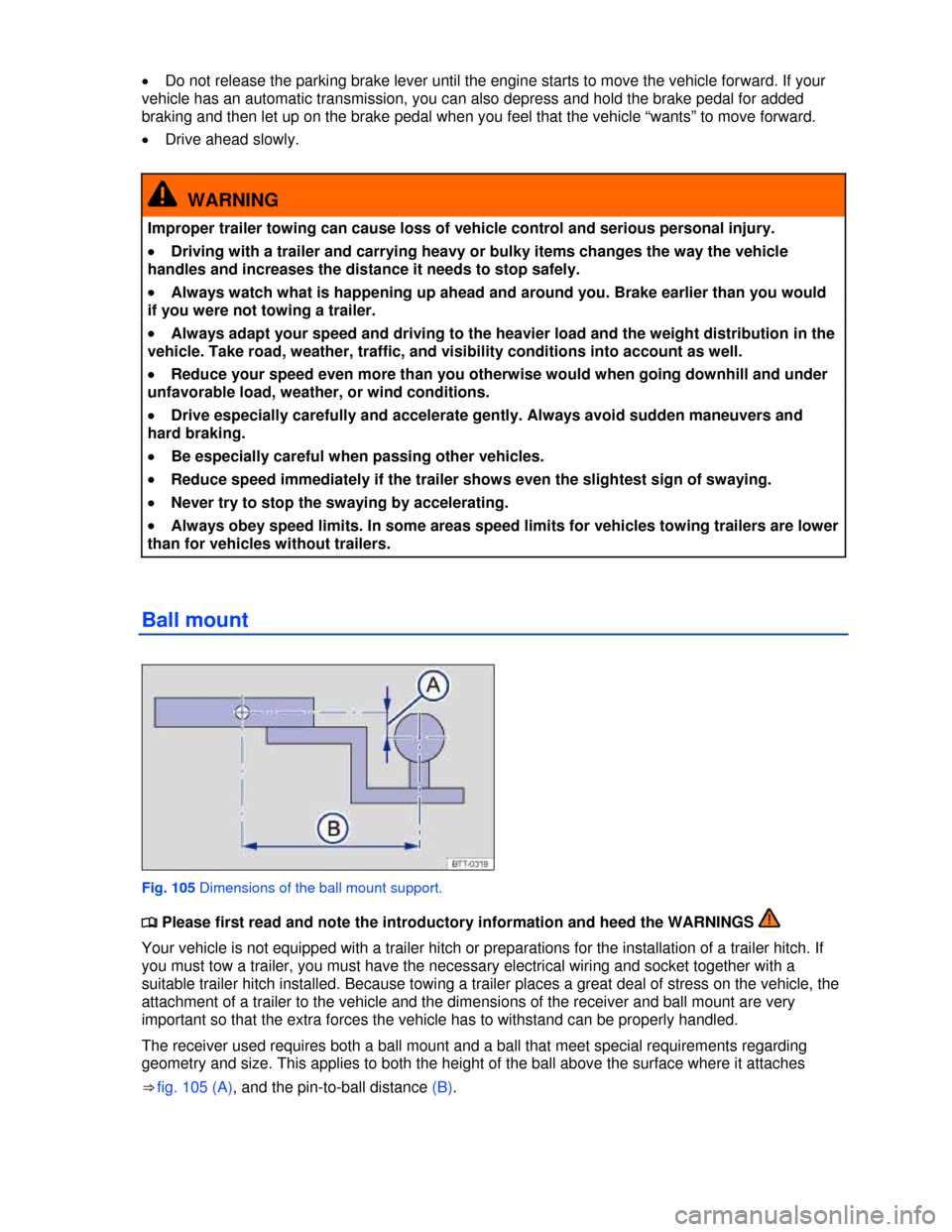
�x Do not release the parking brake lever until the engine starts to move the vehicle forward. If your
vehicle has an automatic transmission, you can also depress and hold the brake pedal for added
braking and then let up on the brake pedal when you feel that the vehicle “wants” to move forward.
�x Drive ahead slowly.
WARNING
Improper trailer towing can cause loss of vehicle control and serious personal injury.
�x Driving with a trailer and carrying heavy or bulky items changes the way the vehicle
handles and increases the distance it needs to stop safely.
�x Always watch what is happening up ahead and around you. Brake earlier than you would
if you were not towing a trailer.
�x Always adapt your speed and driving to the heavier load and the weight distribution in the
vehicle. Take road, weather, traffic, and visibility conditions into account as well.
�x Reduce your speed even more than you otherwise would when going downhill and under
unfavorable load, weather, or wind conditions.
�x Drive especially carefully and accelerate gently. Always avoid sudden maneuvers and
hard braking.
�x Be especially careful when passing other vehicles.
�x Reduce speed immediately if the trailer shows even the slightest sign of swaying.
�x Never try to stop the swaying by accelerating.
�x Always obey speed limits. In some areas speed limits for vehicles towing trailers are lower
than for vehicles without trailers.
Ball mount
Fig. 105 Dimensions of the ball mount support.
�